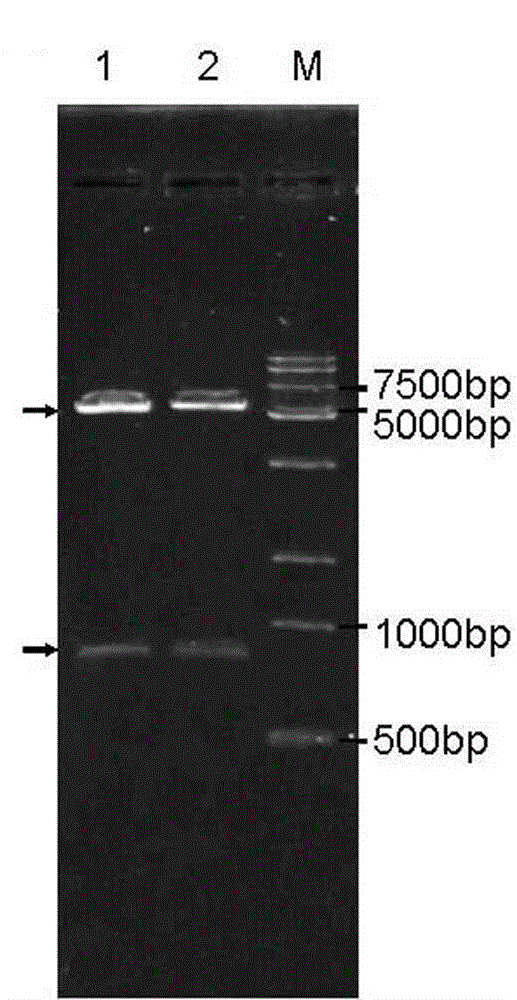Trans-4-hydroxy-L-proline hydroxylase modifying gene with high transformation rate and application thereof
A technology of proline hydroxylase and high conversion rate, applied in the field of genetic engineering and enzyme engineering, can solve the problems of rising separation cost, high production cost, low conversion rate, etc., achieve good industrial application prospects, facilitate purification and separation, The effect of increased conversion rate
- Summary
- Abstract
- Description
- Claims
- Application Information
AI Technical Summary
Problems solved by technology
Method used
Image
Examples
Embodiment 1
[0033]Example 1 Trans-4-hydroxyl-L-proline hydroxylase gene optimization and construction of engineering strains
[0034] (1) Gene optimization
[0035] According to the published data in the NCBI database from Dactylosporangium trans-4-hydroxy-L-proline hydroxylase gene of sp.RH1 phy -1 Sequence information (GenBank ID: D78338.1), gene optimization is carried out according to the following principles: ① Adjust the codon frequency with reference to the codon frequency of the expressed species and replace the codon whose frequency is below 10%, so that the codon usage frequency of the gene sequence Try to be consistent with the optimal codon frequency of the species; ②Reduce the base repeat structure in the sequence as much as possible, so that the RNA secondary structure is relatively simple and stable; ③Make the GC content of the entire DNA sequence as close to 50% as possible .
[0036] (2) Plasmid construction
[0037] The optimized trans-4-hydroxyl-L-proline hydroxyla...
Embodiment 2
[0038] Example 2 Different expression vectors in the host E. coli Transformation experiment of BL21(DE3)
[0039] Transform the above three expression plasmids into Escherichia coli BL21 (DE3), shake the bacteria at 140rpm at 28°C for about 2-3h (OD 600 reach 0.5-1.0), add 0.1-0.5mM IPTG, induce expression at 20°C for 8-12h, collect the bacteria by centrifugation, weigh 1g of the bacteria and resuspend in 10mL transformation reaction solution (containing 200mM L-proline, 200mM α-ketoglutaric acid, 6mM ferrous sulfate, 6mM L-ascorbic acid, 80mM pH 6.5 MES buffer and 1% Nonidet P-40), shaken at 35°C and 140rpm for 72h, centrifuged to remove bacteria, detected by HPLC The generation of trans-4-hydroxyl-L-proline in the serum, and its conversion rate are shown in Table 1. Among them, the transformation rate of the strain containing the expression vector pET-28a-Phy-1 was the lowest, only 62.0%. phy The transformation rate of strains -2 was significantly improved, and the tra...
Embodiment 3
[0042] Example 3 with E. coli BL21-CodonPlus (DE3) as the host transformation experiment
[0043] Transform the expression vectors pET28a-Phy-1 and pET28a-Phy-2 into Escherichia coli BL21-CodonPlus (DE3) respectively, and shake the bacteria at 140rpm at 28°C for about 2-3h (OD 600 reach 0.5-1.0), add 0.1-0.5mM IPTG, induce expression at 20°C for 8-12h, collect the bacteria by centrifugation, weigh 1g of the bacteria and suspend in 10mL transformation reaction solution (containing 200mM L-proline, 200mM α -ketoglutaric acid, 6mM ferrous sulfate, 6mM L-ascorbic acid, 80mM pH 6.5 MES buffer and 1% Nonidet P-40), shake the reaction at 35℃140rpm for 80h, centrifuge to remove the bacteria, and detect the supernatant by HPLC The production of trans-4-hydroxy-L-proline, the transformation rate of the strain containing pET28a-Phy-1 is only 64.3%, while the transformation rate of the strain containing the expression vector pET28a-Phy-2 is as high as 91% ( Figure 3A , Figure 3B )...
PUM
 Login to View More
Login to View More Abstract
Description
Claims
Application Information
 Login to View More
Login to View More - R&D
- Intellectual Property
- Life Sciences
- Materials
- Tech Scout
- Unparalleled Data Quality
- Higher Quality Content
- 60% Fewer Hallucinations
Browse by: Latest US Patents, China's latest patents, Technical Efficacy Thesaurus, Application Domain, Technology Topic, Popular Technical Reports.
© 2025 PatSnap. All rights reserved.Legal|Privacy policy|Modern Slavery Act Transparency Statement|Sitemap|About US| Contact US: help@patsnap.com



